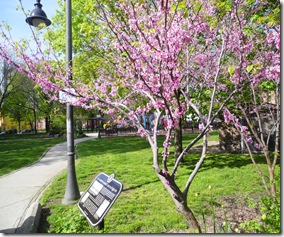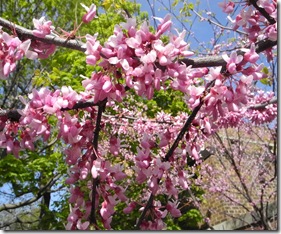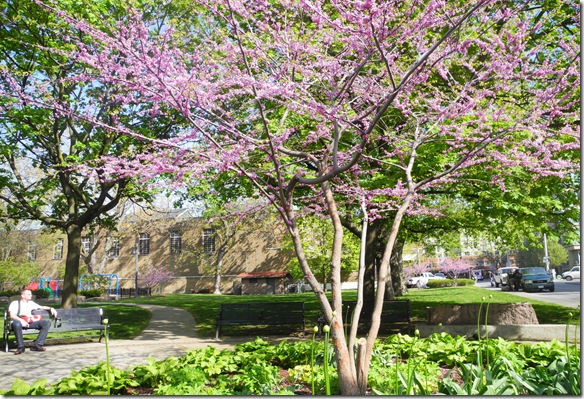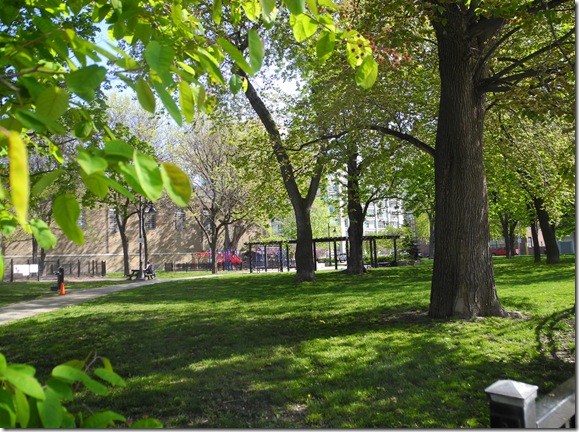It’s spring! The redbud are in bloom in parks and gardens throughout the city. The large shrub (small tree) is a native species that grows as far south as Florida, its range extending north to southern Ontario. During the last decade, with the warming of the Toronto winters, it has become more common in the parks and gardens throughout the city. Its showy flowers range from light pink to dark purple. The 1/2 inch long flowers appear in clusters on the bare branches before the leaves appear. Its scientific name is “cercis canadensis.” The species that grows in Toronto is the “eastern redbud.”
Redbud trees in St. Andrew’s Park
The redbud tree at the corner of Brant and Adelaide Streets in St. Andrew’s Park
St. Andrew’s Park (May- 2012)
When visiting St. Andrew’s Park, it is worth stopping for a few moments to read the historic plaque at the northeast corner of the square. It contains several photos from earlier decades and outlines a brief history of the park.
A history of St. Andrew’s Park, site of Toronto’s third farmers’ market square
During the late 1830s, it was becoming obvious that the St. Lawrence Market was too distant to serve the needs of the residents of Toronto who were living to the west of Peter Street. A new market square was planned, and the land grant was dated May 22, 1837. The northern end of the square was to be 337 feet long, fronting on Richmond Street, and the depth was to be 173 feet. The site consisted of one and three-quarters acres. The eastern limit of the square was Brant Street, directly across from where the condominium “50 Camden Street” would one day appear. The market square was bounded on the west by Maud Street and on the south by Adelaide. The new market was named the “West City Market.” Although this event did not illuminate the city like the lights of the West End of today’s London, it promised a sunny future for the nineteenth century community residing near the market square.
Finally, a few homes were built in the surrounding area. Most homes were of wood, but more brick dwellings were being constructed. On Queen Street, to the east of Spadina, rows of two-storey buildings appeared, possessing shops on the street level, and residences on the floors above. Along the waterfront were many fine homes. Since its incorporation three years earlier, the city was rapidly expanding.
It is not certain when the citizens of York commenced attending the West City Market. However, it is likely that sometime during the 1840s, a small, seasonal market occurred on Saturday mornings, attended mostly by women, as the majority of the men were required to work at their places of daily employment, Saturday being a work-day. Slowly the market grew in size, and in 1850, the city hired the architect Thomas Young to design a frame building to protect shoppers from the weather. Young, born in England in 1805, had previously designed King’s College, Toronto, and the wooden building for the St. Patrick’s Market on Queen Street.
The wooden St. Andrew’s Market building was constructed in the centre of the market square and contained generous interior space for stalls. A police station and a fire bell were also within the building. Along the out-side walls were produce stands, with canvas awnings sheltering the patrons from the hot summer sun and the rains of spring and autumn, as well as the snows of winter. At the south end of the square, on Adelaide Street, they erected a shelter to protect the horses from the elements. The remainder of the square was green space to accommodate carts, wagons, and the Saturday-morning shoppers. Friends greeted friends, in the background the sound of neighing horses and rumbling wagon wheels.
In 1857, they changed the name of the market to St. Andrew’s Market, as the site was in St. Andrew’s Ward, Queen Street being the northern boundary line. There were now three markets within the city, the other two being the St. Lawrence (1803) at King and Jarvis Streets, and the St. Patrick’s Market (1836) on Queen Street, between McCaul and John Streets. The St. Lawrence Market remains popular today, and the St. Patrick’s Market still exists on Queen Street West, although the present building dates from the year 1912.
St. Patrick’s Market was eventually renamed the Queen Street Market. The small square to the north of the market building retains the former name of St. Patrick’s. During warm weather, people sit in this secluded park to drink coffee, chat, or suck on tobacco smoke. Others enjoy a sandwich or slice of pizza. From the square, a little of the Toronto of old remains visible, the houses and laneways clearly portraying the historic lineage of the area.
In 1857, only the St. Lawrence at King and Jarvis Streets exceeded the importance of the St. Andrew’s Market. On a busy Saturday morning, the carriages and horses, as well as the numerous carts of the citizens of Toronto, crowded St. Andrew’s Market. It was a gathering place to socialize and chat with friends and neighbours. Housewives purchased vegetables, grains, meat, and fish.
A resident of Toronto wrote, “At Christmas time, the abundance of the market would do credit to any city in the world.” Though this was exaggeration, it expressed the writer’s pride as he gazed at the abundance, where many rows of dressed fowl were hanging from numerous poles suspended above the stalls and shops, whole pigs and sides of beef adding to the display. Counters with an array of beef, pork, and lamb greeted the eyes, alongside baskets of fresh eggs. Bushels of root vegetables were positioned side by side and in some shops were stacked against the rear walls. At Christmas, even the fish stalls managed to display fresh product. It was an amazing Yuletide scene.
I have spent much of my adult life researching and photographing Toronto. I love the city. It has provided the background for my books, one of which, “The Villages Within”, was nominated for the Toronto Heritage Awards. If interested in novels with a Toronto setting, descriptions of the books are available by following the link: https://tayloronhistory.com/2012/03/22/toronto-author-publishes-seventh-novel/
They can be purchased in soft cover or electronic editions. All books are available at Chapters/Indigo and on Amazon.com. The electronic editions are less that $4. Follow the links:
There Never Was a Better Time: http://bookstore.iuniverse.com/Products/SKU-000056586/THERE-NEVER-WAS-A-BETTER-TIME.aspx
Arse Over Teakettle: http://bookstore.iuniverse.com/Products/SKU-000132634/Arse-Over-Teakettle.aspx
The Reluctant Virgin; http://bookstore.iuniverse.com/Products/SKU-000188306/The-Reluctant-Virgin.aspx
The Villages Within: http://bookstore.iuniverse.com/Products/SKU-000175211/The-Villages-Within.aspx
Author’s Home Page: https://tayloronhistory.com/
Authors can be contacted at: [email protected]



